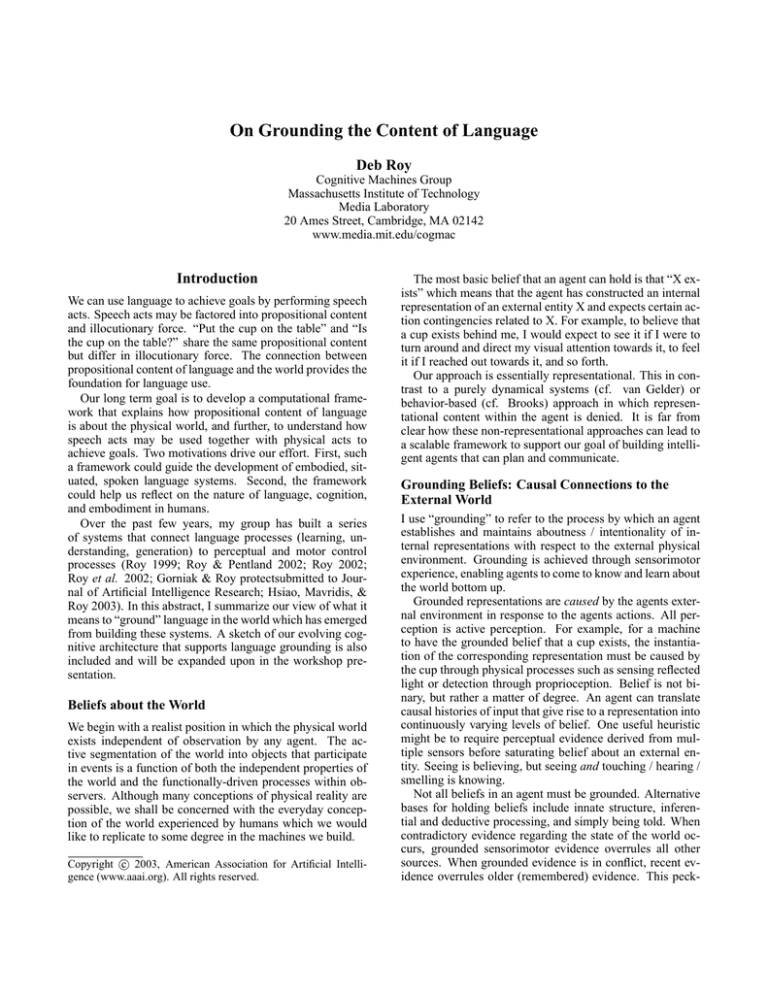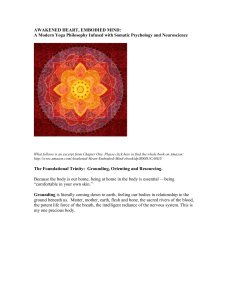
On Grounding the Content of Language
Deb Roy
Cognitive Machines Group
Massachusetts Institute of Technology
Media Laboratory
20 Ames Street, Cambridge, MA 02142
www.media.mit.edu/cogmac
Introduction
We can use language to achieve goals by performing speech
acts. Speech acts may be factored into propositional content
and illocutionary force. “Put the cup on the table” and “Is
the cup on the table?” share the same propositional content
but differ in illocutionary force. The connection between
propositional content of language and the world provides the
foundation for language use.
Our long term goal is to develop a computational framework that explains how propositional content of language
is about the physical world, and further, to understand how
speech acts may be used together with physical acts to
achieve goals. Two motivations drive our effort. First, such
a framework could guide the development of embodied, situated, spoken language systems. Second, the framework
could help us reflect on the nature of language, cognition,
and embodiment in humans.
Over the past few years, my group has built a series
of systems that connect language processes (learning, understanding, generation) to perceptual and motor control
processes (Roy 1999; Roy & Pentland 2002; Roy 2002;
Roy et al. 2002; Gorniak & Roy protectsubmitted to Journal of Artificial Intelligence Research; Hsiao, Mavridis, &
Roy 2003). In this abstract, I summarize our view of what it
means to “ground” language in the world which has emerged
from building these systems. A sketch of our evolving cognitive architecture that supports language grounding is also
included and will be expanded upon in the workshop presentation.
Beliefs about the World
We begin with a realist position in which the physical world
exists independent of observation by any agent. The active segmentation of the world into objects that participate
in events is a function of both the independent properties of
the world and the functionally-driven processes within observers. Although many conceptions of physical reality are
possible, we shall be concerned with the everyday conception of the world experienced by humans which we would
like to replicate to some degree in the machines we build.
c 2003, American Association for Artificial IntelliCopyright gence (www.aaai.org). All rights reserved.
The most basic belief that an agent can hold is that “X exists” which means that the agent has constructed an internal
representation of an external entity X and expects certain action contingencies related to X. For example, to believe that
a cup exists behind me, I would expect to see it if I were to
turn around and direct my visual attention towards it, to feel
it if I reached out towards it, and so forth.
Our approach is essentially representational. This in contrast to a purely dynamical systems (cf. van Gelder) or
behavior-based (cf. Brooks) approach in which representational content within the agent is denied. It is far from
clear how these non-representational approaches can lead to
a scalable framework to support our goal of building intelligent agents that can plan and communicate.
Grounding Beliefs: Causal Connections to the
External World
I use “grounding” to refer to the process by which an agent
establishes and maintains aboutness / intentionality of internal representations with respect to the external physical
environment. Grounding is achieved through sensorimotor
experience, enabling agents to come to know and learn about
the world bottom up.
Grounded representations are caused by the agents external environment in response to the agents actions. All perception is active perception. For example, for a machine
to have the grounded belief that a cup exists, the instantiation of the corresponding representation must be caused by
the cup through physical processes such as sensing reflected
light or detection through proprioception. Belief is not binary, but rather a matter of degree. An agent can translate
causal histories of input that give rise to a representation into
continuously varying levels of belief. One useful heuristic
might be to require perceptual evidence derived from multiple sensors before saturating belief about an external entity. Seeing is believing, but seeing and touching / hearing /
smelling is knowing.
Not all beliefs in an agent must be grounded. Alternative
bases for holding beliefs include innate structure, inferential and deductive processing, and simply being told. When
contradictory evidence regarding the state of the world occurs, grounded sensorimotor evidence overrules all other
sources. When grounded evidence is in conflict, recent evidence overrules older (remembered) evidence. This peck-
ing order reflects the privileged status of immediate physical
couplings in our representational framework. When immediate senses are in contradiction (e.g., what an agent sees
versus what it feels), confusion regarding the state of the
world results.
Two Motivations for Grounding
There are at least two strong motivations for grounding.
First, for a machine to interactively respond to numerous
changes in its environment, the only feasible approach is for
the machine to extract its own representations. The alternative, which would require some form of human-in-the-loop
is not an option for real-time systems that interact significantly with their environment.
The second reason for grounding is the problem of “representational drift”. Since the world is necessarily more complex than an agent’s representation of it, the representation
is only an approximation of the real thing. The privileged
position of physical coupling allows agents to stay synchronized with the world by overriding inaccurate models and
predictions. If the coupling is removed (i.e., the agent has
no grounding), then internal approximations of the external world will drift over time. The amount and nature of
drift will depend on the precision of the agents internal models. In domains such as chess in which complete and accurate representations are feasible, grounding is unnecessary.
Since our goal is to build physically situated, interactive conversational systems – conversational robotic helping hands,
car navigation systems, voice controlled appliances, and so
forth – grounding matters.
An Architecture for Grounding Language
A powerful bond is formed between agents that hold
grounded beliefs about the same external entity. Shared
grounding can help catalyze the alignment of networks of
internal representations across agents (see (Goldstone & Rogosky 2002) for related ideas). By associating words with
categories of beliefs, agents are able to cause partial alignments of representations across minds by uttering words according to linguistic conventions. Figure 1 is a snapshot of
our architecture that has emerged through the construction
of several grounded language systems that build on this general idea. Learning algorithms have also been developed for
isolated tasks such as word to visual category acquisition,
grammar learning, etc., which are not shown in this figure.
While it is beyond the scope of this abstract to describe the
architecture in detail, I will highlight some aspects that are
germane to the above discussion on grounding. The physical robot (in the figure, Ripley, a manipulator robot shown
to the right) is connected to the architecture through motor
control and perceptual feedback. A mental model holds a
partial representation of the robot’s environment. A model
of Newtonian dynamics is used to update the contents of the
model at regular times steps. The mental model provides an
amodal / cross-modal representation of the world and serves
as a medium for connecting language, vision, motor control,
and planning.
For Ripley to hold a grounded belief, objects are instantiated in the mental model by either the Visual Grounder or
the Proprioceptive Grounder. These modules are driven by
camera, touch, and force sensors mounted on the robot that
cause mental objects to be created, modified, or destroyed
based on sensorimotor evidence. The mental model strives
to maintain a consistent model of the robot’s immediate environment using a combination of signal processing and geometric reasoning algorithms. Conflicts between sensor signals are resolved by giving preference to recent observations
over older ones.
The language understanding and generation modules interact with the mental model and planning components via
lexical and grammatical structures. All referential words
that can be bound to objects, properties, actions, and spatial relations are defined using a combination of three representational elements: sensorimotor schemas, run-time measurement functions, and sensory expectation functions. For
example, the semantics of lift is grounded in a sensorimotor schema that can guide Ripley through visually servoed
motions to grasp and lift objects. The semantics of heavy
and light are defined in terms of sensory expectation functions defined in terms of accumulated proprioceptive forces
that would be experienced when executing the lift schema.
Force accumulation thus serves as the measurement function
that links lift with heavy. This approach to lexical grounding provides a means to ground words, and also to ground
relations between words.
Language processing algorithms use these lexical definitions along with simple grammars to interpret and generate
situated spoken utterances. Thematic roles of words according to a grammar are translated into compositional structure
of underlying representations. The argument structure of
verbs is mirrored by the argument structure of corresponding sensorimotor schema (similar to (Narayanan 1997)). We
have demonstrated several verbal behaviors including visual scene description generation, understanding visuallygrounded referring expressions, and most recently, primitive
speech-based control of a manipulator robot.
Summary
In our approach, grounding enables robotic systems to establish and maintain representations that are closely coupled to
the world via sensorimotor loops, yet internalized and available for use by planning and communication processes. Our
current efforts are focused on the design of goal structures
and distributed planning mechanisms that will enable our
robots to use speech acts with grounded propositional content in fluid coordination with motor acts to achieve goals.
Acknowledgments
This work is in collaboration with members of the Cognitive
Machines Group at the MIT Media Lab. Development of
the architecture described in this abstract is led by Kai-Yuh
Hsiao, Nikoloas Mavridis, and Peter Gorniak.
References
Goldstone, R., and Rogosky, B. 2002. Using relations
within conceptual systems to translate across conceptual
systems. Cognition 84:295–320.
Innate knowledge
Mental Model
Top-down
instantiator
World
Model
Conceptual
LTM
Visual
Grounder
Model
Prediction /
Update
Grammar
Lexicon
Proprioceptive
Grounder
Dynamics
Model
Language
Understander
Speech
Recognizer
Language
Generator
Speech
Synthesizer
Visualizer
Virtual
viewpoint
Planner
Motor
Controller
Goal
Lattice
Wear / Stress
Monitor
Figure 1: Architecture designed to support grounded language.
Objecter
Gorniak, P., and Roy, D. submitted to Journal of Artificial
Intelligence Research. Grounded semantic composition for
visual scenes.
Hsiao, K.; Mavridis, N.; and Roy, D. 2003. Coupling
perception and simulation: Steps towards conversational
robotics. In Proceedings of IEEE/RSJ International Conference on Intelligent Robots and Systems.
Narayanan, S. 1997. KARMA: Knowledge-based active
representations for metaphor and aspect. Ph.D. Dissertation, University of California Berkeley.
Roy, D., and Pentland, A. 2002. Learning words from
sights and sounds: A computational model. Cognitive Science 26(1):113–146.
Roy, D.; Gorniak, P.; Mukherjee, N.; and Juster, J. 2002.
A trainable spoken language understanding system for visual object selection. In International Conference of Spoken Language Processing.
Roy, D. 1999. Learning Words from Sights and Sounds: A
Computational Model. Ph.D. Dissertation, Massachusetts
Institute of Technology.
Roy, D. 2002. Learning visually-grounded words and syntax for a scene description task. Computer Speech and Language 16(3).



